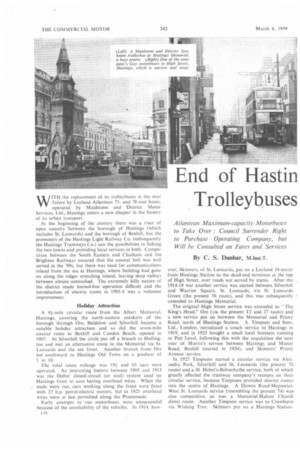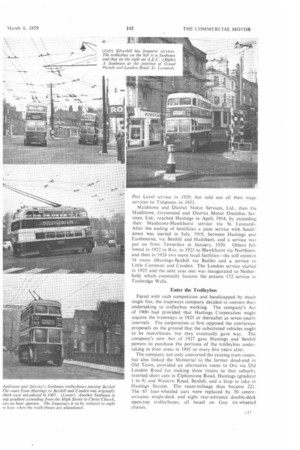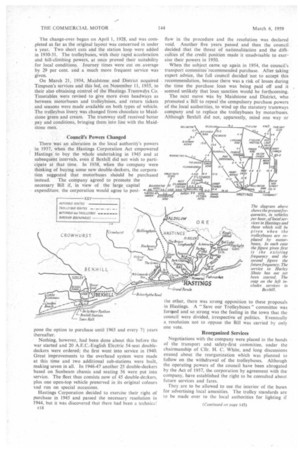End of Hastin Trolleybuses
Page 58

Page 59

Page 60

Page 63

If you've noticed an error in this article please click here to report it so we can fix it.
Atlarttean Maximum-capacity Motorbuses to Take Over : Council Surrender Right to Purchase Operating Company, but Will be Consulted on Fares and Services By C. S. Dunbar, minst.T.
WITH the replacement of its trolleybuses in the near future by Leyland Atlantean 73and 78-seat buses, operated by Maidstone and District Motor Services, Ltd., Hastings enters a new chapter in the history of its urban transport.
At the beginning of the century there was a tract of open country -between the borough of Hastings (which includes St. Leonards) and the borough of Bexhill, but the promoters of the Hastings Light Railway Co. (subsequently the Hastings Tramways Co.) saw the possibilities in linking the two towns and providing local services in both. Competition between the South Eastern and Chatham and the Brighton Railways ensured that the coastal belt was well served in the '90s, but there was need for communications inland from the sea at Hastings, where building had gone on along the ridges stretching inland, leaving deep valleys between almost untouched. The extremely hilly nature of the district made horsed-bus operation difficult and the introduction of electric trams in 1905-6 was a welcome improvement.
Holiday Attraction
A 91-mile circular route from the Albert Memorial. Hastings. covering the north-eastern outskirts of the borough through Ore, BaldsIow and Silverhill became a notable holiday attraction and so did the seven-mile coastal route to Bexhill and Cooden Beach, opened in 1907. At Silverhill the circle put off a branch to Hailington and met an alternative route to the Memorial via St. Leonards and the sea front. Another branch from Ore led southward to Hastings Old Town on a gradient of 1 in 10.
The total route mileage was 191 and 65 cars were operated. An interesting feature between 1905 and 1913 was the Dolter closed-circuit (or stud) system used on Hastings front to save having overhead wires. When the studs wore out, cars working along the front were fitted with 27 h.p. petrol-electric motors, but in 1921 overhead wires were at last permitted along the Promenade.
Early attempts to runmotorbuses were unsuccessful because of the unreliability of the vehicles. In 1914, how ever, Skinners, of St. Leonards, put on a Leyland 34-seater from Hastings Station to the dead-end terminus at the top of High Street, over roads not served by trams. After the 1914-18 war another service was started between Silverhill and Warrior Square, St. Leonards, via St. Leonards Green (the present 76 route), and this was subsequently extended to Hastings Memorial.
The original High Street service was extended to "The King's Head," Ore (via the present T2 and 27 rpute) and a new service put on between the Memorial and Priory Road, north of Hastings Station. A. Timpson and Sons, Ltd., London, introduced a coach serviCe to Hastings in 1919, and in 1925 bought a small local business running to Pett Level, following this with the acquisition the next year of Morris's service between Hastings and Manor Road, Bexhill (started in 1924), and Skinners' Priory Avenue service.
In 1927 Timpsons started a circular service via Alexandra Park, Silverhill and St. Leonards (the present 76 route) and a St. Helen's-Bulverhythe service, both of which greatly affected the tramway company's receipts on their circular service, because Timpsons provided shorter routes into the centre of Hastings. A Downs Road-MemorialWest St. Leonards service (resembling the present 74) was also competitive, so was a Memorial-Halton Church direct route. Another Timpson service was to Cram/burst via Wishing Tree. Skinners put on a Hastings Station.
Pen Level service in 1929, but sold out all their stage services to Timpsons in 1933.
Maidstone and District Motor Services, Ltd., then the Maidstone, Gravesend and District Motor Omnibus Services, Ltd., reached Hastings in April, 1914, by extending their Maidstone-Hawkhurst service via St. Leonards. After the ending of hostilities a joint service with Southdown was started in July, 1919, between Hastings and Eastbourne, via 13exhill and Hailsham, and a service was put on from Tenterden in January, 1920. Others followed in 1922 to Rye. in 1923 to Hawkhurst via Northiam. and then in 1924 two more local facilities—the still existent 34 route (Hastings-Bexhill via Battle) and a service to Little Common and Cooden. The London service started in 1925 and the next year one was inaugurated to Netherfield, which eventually became the present 152 service to Tunbridge Wells.
Enter the Trolkybus Faced with such competition and handicapped by much single line, the tramways company decided to convert their undertaking to trolleybus working. The company's Act of 1900 had provided that Hastings Corporation might acquire the tramways in 1925 or thereafter at seven-yearly intervals. The corporation at first opposed the conversion proposals on the ground that the substituted vehicles ought to be motorbuses, but they eventually gave way. The company's new Act of 1927 gave Hastings and Bexhill powers to purchase the portions of the trolleybus undertaking in their areas in 1945 or every five years after.
The company not only converted the existing tram routes, but also linked the Memorial to the former dead-end in Old Town, provided an alternative route to Ore via Old London Road (so making three routes to that suburb), inserted short cuts in Elphinstone Road, Hastings (gradient 1 in 9) and Western Road, Bexhill, and a loop to take in Hastings Station. The route-mileage thus became 221. The 65 four-wheeled cars were replaced by 50 centreentrance single-deck and eight rear-entrance double-deck open-top trolleybuses, all based on Guy six-wheeled chassis. The change-over began on April 1, 1928, and was completed as far as the original layout was concerned in under a year. Two short cuts and the station loop were added in 1930-31. The trolleybuses, with their rapid acceleration and hill-climbing powers, at once proved their suitability for local conditions. Journey times were cut on average by 29 per cent. and a much more frequent service was given.
On March 21, 1934, Maidstone and District acquired Timpson's services and this led, on November 11, 1935, to their also obtaining control of the Hastings Tramwa'ys Co. Timetables were revised to give more even headways as between motorbuses and trolleybuses, and return tickets and seasons were made available on both types of vehicle. The trolleybus livery, was changed from chocolate to Maidstone green and cream. The tramway staff received• better pay and conditions, bringing them into line with the Maidstone men.
_ Council's Powers Changed
WOWS TREE
There was an alteration in the local authoritYs powers in 1937, when the Hastings Corporation Act empowered Hastings to buy the whole undertaking in 1945 and at subsequent intervals, even if Bexhill did not wish to participate at that time. In 1938, when the company were thinking of buying some new double-deckers, the corporation suggested that motorbuses should be purchased MrE instead. The company agreed to promote the
pone the option to purchase until 1965 and every 7+ years thereafter.
Nothing, however, had been done about this before the war started and 20 A.E.C.-English Electric 54-seat doubledeckers were ordered; the first went into service in 1940. Great improvements to the overhead system were made at this time and two additional sub-stations were built, making seven in all. In 1946-47 another 25 double-deckers based on Sunbeam chassis and seating 56 were put into service. The fleet thus consists now of 45 double-deckers, plus one open-top vehicle preserved in its original colours and run on special occasions.
Hastings Corporation decided to exercise their right of purchase in 1945 and passed the necessary resolution in 1944, but it was discovered that there had been a technica!
118
flaw in the procedure and the resolution was declared void. Another five years passed and then the council decided that the threat of nationalization and the difficulties of the credit position made it unadvisable to exercise their powers in 1950.
When the subject came up again in 1954, the council's transport committee recommendedpurchase. After taking expert advice, the full council decided not to accept this recommendation, because there was a risk of losses during the time the purchase loan was being paid off and it seemed unlikely that loan sanction would be forthcoming.
The next move was by Maidstone and District, who promoted a Bill to repeal the compulsory purchase powers of the local authorities, to wind up the statutory tramways company and to replace the trolleybuses by motorbuses. Although Bexhill did not, apparently, mind one way or
the other, there was strong opposition to these proposals in Hastings. A "Save our Trolleybuses " committee was forrped and so strong was the feeling in the town that the council were divided, irrespective of politics. Eventually a. resolution not to oppose the Bill was carried by only one vote.
Reorganized Services Negotiations with the company were placed in the hands of the transport and safety-first committee, under the chairmanship of Ur. H. C_ White, and long discussions ensued about the reorganization which was planned to follow on the withdrawal of the trolleybuses. Although the operating powers of the council have been abrogated by the Act of 1957, the corporation by agreement with the company, have established the right to be consulted about future services and fares.
They are to be allowed to use the interior of the buses for advertising local amenities. The trolley standards are to be made over to the local authorities for lighting if 7 so desire, otherwise, they will be removed at the npany's expense. Those on the front will definitely nain and their transfer will be accompanied by a contrition of £9,000 from the company towards the cost of widing new lighting equipment along the sea-front line. is follows an arrangement reached between the parties to ver certain obligations assumed by the company in an t of 1920, when overhead traction was provided on the int.
Mere will be a loss of rateable value on the trolley ndards and the ratepayers will be £2,000-£2,500 a year rse off under this heading. This, however, will be more in offset, in the opinion of the municipal leaders, by tidstone and District's revising all fares to conform with at is called the Tunbridge Wells scale.
[n this connection it is interesting to note that whereas 1949 the fare from Cooden to Hastings Memorial was single, 1 s. 2d. return, today it is Is. 2d. single, Is. 10d. urn, The fare from Hollington-Memorial via Bohemia ; gone up from 3d. single to 7d. and so on throughout system. A Id. Minimum was still in force 10 years Y; it is now, of course, 2d. The company think that the ver scales will reduce takings in the two boroughs by a )stantial amount, but are banking on making up this s by reduced operating costs. The 54and 56-seat Ileybuses will be replaced by Leyland Atlantean 73and seaters, Four Trolleybus Services
ftc trolleybuses are now worked on four services. The ough route, T8, from Cooden to Hastings does not ternate at the Memorial, as it did originally, but continues Queen's Road to Park crossroads. Two buses an ur run from Cooden, three per hour from the Metrole, Bexhill. and four from Bexhill Central Station. rmerly there were also T5 (Cooden-St. Helen's via )hinstone Road) and T7, a short working on this route .ween Bexhill and Ore. Cooden, Bexhill and Ore are I linked but by motorbus services 35 and 51. These e a different route at the two extremities, but otherwise plicate the trolleybuses.
[6 is the old tram circular, except that the short cut of )hinsione Road is used, whereas the trams detoured via Helen's Road (now covered by T8), St. Helen's Park ad and Laton Road. These roads are still wired and re formerly used by T12, which was yet another Oreoden service.
[tie round trip on the circle takes 42 minutes and is run 45-minute intervals. in practice, this long gap applies ly between Redlake Road, Ore and "The Harrow,ldslow, as other services cover the rest of the route. from Hollington runs to Ore via Bohemia and Queen's ad with six buses a day going on to St. Helen's, of ich three run round the circle to Silverhill. Weekday idway is six minutes between Silverhill and Ore.
Motorbus Duplication F.,xcept for a slight variation at Hollington, motorbus ite 133 duplicates this service between Hollington and ; centre. Ti! also connects Hollington and Ore, but London Road (St. Leonards), Old Town and Harold This gives a six-minute headway between Silverhill I Ore over the alternative route; it also works every 12 nutes between Hollington and St. Helen's, giving, with , a six-minute service between Hollington and Silverhill. Frequencies to St. Helen's are increased on Saturday ernoons. Formerly there were three more Silverhille services. They were TI., running from Hollington via hernia, Old Town and Old London Road, T3 via St. onards and Elphinstone Road, and TR from Hollington Bohemia and Harold Road. T4 was a short on Ti. T10 ran along the front between Bulverhythe and the Fishmarket. The loop to Hastings Station has not been used by trolleybuses for some years. Motorbus route 27 runs thence to Ore, via Old Town and Old London Road, and 134 to Fairlight Glen via Priory Road and Ore.
It will be seen that since the war there has been a great deal of simplification. Twelve trolleybus services have been reduced to four, mainly by cutting out alternative routes between pairs of points. Services are still given over the same roads, with two minor exceptions, but instead of passengers waiting for a direct service in every case—usually at long headways—they now have in some cases to change.
In addition to the longer-distance services entering Hastings and the cross-town bus routes already mentioned, there are three other cross-town bus services and the ex-Timpson circular linking Silverhill with Alexandra Park via the centre. On the front between Grand Parade, St. Leonards and Hastings centre there are altogether 18 motorbus and two trolleybus services.
Changed Frequencies
The winter trolleybus schedules need 33 vehicles. It is hoped that the use of Atlanteans will enable the replacing services to be run all the year round with only 33 motorbuses in addition to those already in the two towns. A certain amount of the duplication which necessarily exists at present will be cut out.
It will be noted from the accompanying diagram, for example, that Bohemia Road (now served by both types of vehicle) will have three buses less an hour and the stubend of the Hollington route (which has been as well served as it has only because a convenient trolleybus terminus had to be found) will drop from 10 to four buses (excluding the M. and D. country services passing into Hastings). On the other hand, the Blackman Avenue neighbourhood, in the same part of Hastings, will get an improved service to cover housing development.
Another trolleybus leg with an unnecessarily high frequency—that from Park Gates to Park Cross Roads—will be cut by four buses an hour when the latter point ceases to be a terminus. The long outer suburban trolleybus circular T2 will not be exactly replaced, because the circular motorbus service which will cover the same ground between Ore, Baldslow and Silverhill will then work via St. Leonards and the front, up to Priory Avenue and back. and on via Priory Road to Ore.
Service to be Split
The motorbus service from St. Helen's Church via Fearon Road will be split at Grand Parade, one part going, as now, on the Crowhurst Road to Wishing Tree and the other going through Bexhill to Cooden over the present route of 35. There will still be through motorbuses to Bexhill from Ore ("King's Head"), but instead of following Priory Road as do the present 35 and 51, one will be diverted via Park Gates and the other via High Street, both so covering ex-trolleybus routes.
Operated by Atlanteans, these two services will provide large double-deckers in place of the existing single-deckers, an advantage not only along the front, but particularly at the Sidley end, where the lowering of the road under Sackville Arch (a joint enterprise by the corporation and the company) has enabled the low-height Leylands to be employed.
[This article concludes a series of three dealing with passenger transport in the Sussex urban areas of (a) Eastbourne, (b) Brighton, Hove, Portslade and South wick, and (c) Hastings and Bexhill. The report on Eastbourne appeared on January 30 and the contribution on Brighton and district on February 6.1




















































































































